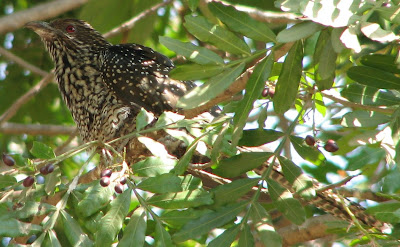I usually go to Lalbagh early in the morning, around 6:30 am.
It is possible to see a lot of Parakeets there. Their characteristic calls usually give them away, I've seen them in gregarious groups; often high up on the trees that circle the lake. If one walks around the lake, particularly near the chickoo trees, it's possible to see and photograph them.
In flight, they are rather fast and Im not skilled enough to capture them then.
The parakeets in Lalbagh, that I've seen, are all Rose Ringed Parakeets. They have a pink and black ring around their necks. This ring is only visible in the male birds and not in the female.
Finding their nests, makes it easy to photograph them. This little bird, surprised me by suddenly popping its head out while I was trying in vain to capture a Thickbilled Flower Pecker.
 Rose Ringed Parakeet - Female possibly juvenile
Rose Ringed Parakeet - Female possibly juvenile
This bird was being mobbed by a bunch of sly Mynas that had their nest higher up in the same tree. The bird would try to come out of its hole, and the Mynas would fly at it, making it go back in again.
Walking near the chickoo trees, which were fruiting, I was able to see this magnificent male bird.
The rose and black ring is clearly visible and it was very busy with its chickoo to notice me.

Adult Male - Rose Ringed Parakeet
Near the Glass house building, I saw this bird and had no clue as to what it was, until I got home and checked Dr. Salim Ali's book.

Koel - Female
Near by was this fearless little squirrel that simply refused to move, no matter how close I went to its tree. 
On my way out, passed by another parakeet nest (different from the first). The female had just landed on the tree, she put her head into the hollow and then simply refused to take it out. I waited for around 5 min before leaving her.
The Alexanderine Parakeets have a red patch on their shoulder. The males of that species also have the rose ring. The red patch there fore, is the only way to distinguish them.
1.JPG) Female - Note the absence of the Rose coloured Ring
Female - Note the absence of the Rose coloured Ring All in all, it was a successful outing. The Thickbilled flower peckers ( small brown birds that sit up high on the trees ) valiantly eluded being caught by my camera. Another such bird was the Ashy Wren Warbler that hopped from tree to tree, in and out of bushes and when in one place, it would jump about, not sitting still for a single minute. After 15 min, and several fuzzy pictures later, I gave up.





